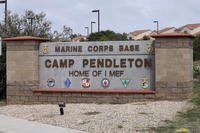"It's not over, it's not over," Sen. John McCain said of the Vietnam War.
McCain, a POW in Hanoi for five years, had been asked by Military.com on Tuesday night whether he agreed with documentary filmmaker Ken Burns that Vietnam is still "unfinished business" -- for the U.S. and for Vietnam.
"It's true. The war's not over" in the minds of Americans, McCain said, before entering the Kennedy Center Opera House for a preview and panel discussion on the 10-part, 18-hour PBS series "The Vietnam War," co-directed by Burns and Lynn Novick, that will begin airing Sunday night.
"It's the right time to tell it," McCain said. "Maybe we can look back at the Vietnam conflict and make sure we don't make the same mistakes that we did before."
John Kerry, the former senator from Massachusetts and former secretary of state, said the nation still needs a reckoning with Vietnam.
"I think this film will be enormously helpful. People can make their own judgment," he said.
McCain and Kerry in ways represent the yin and yang of the war.
McCain was career Navy. He was flying an A4E-Skyhawk when he was shot down.
Kerry commanded a Swift Boat. He got out of the Navy when he could and, for a time, led the group Vietnam Veterans Against the War.
Yet they became friends when happenstance put them next to each other on a long-ago plane ride to the Mideast, Kerry said.
They would later join in pushing former President Bill Clinton to re-establish relations with Vietnam -- a politically dicey thing for Clinton, given his own history with the draft and the anti-war movement.
Burns said later that he relied on McCain and Kerry for encouragement in the 10-year preparation of the series.
Both McCain and Kerry appear in archival footage in the series, but Burns said he did not interview them. He wanted to avoid the appearance of a political slant in the project.
Immense Generational Baggage
Novick said that the subject matter came with immense generational baggage and the track record of previous attempts at storytelling that devolved into coulda', shoulda', woulda' blame games.
"There's no agreement among scholars, or Americans or Vietnamese, about what happened -- the facts, let alone whose fault, let alone what we're supposed to make of it," she said.
"Lynn and I believe that the Vietnam War was the most important event in American history since [World War II] and so much of the division that we experience today -- the hyper-partisanship that besets us -- we think the seeds of that were sown in Vietnam," Burns said.
"Many of us have buried our heads in the sand about it. It didn't turn out very well for us," he said. "We are hoping that we can change that with this film."
According to the promotional material, the series "will open up conversations -- sometimes painful and long overdue -- about the legacy of the war and what we can learn from it today."
Before playing clips from the series, Burns asked the Vietnam veterans in the audience to stand. There was applause.
Then he asked those who protested against the war to stand with the vets. There was more applause.
"I couldn't tell the difference," Burns joked.
America's 20th Century Civil War
The theater went dark for the first clip from the opening of the series. There was a rumbling sound and the foreboding whup whup of a helicopter over a blank screen.
Then the crackle of weapons on full automatic. Cut to stock footage of bare-armed U.S. troops in the flak jackets of the time firing at something, somewhere. Mortar rounds walk up a too green hillside.
The narrator gives some statistics for context. Overlay Bob Dylan: "Tell me where have you been my blue-eyed son … "
Then the film goes backward, literally. The cameras are thrown into reverse, past the fall of Saigon, past the napalm, past the protests and counter-protests. The effect is that the viewer is thrust back into the '60s, about to be immersed, again, in what has often been described as America's 20th Century Civil War.
Drawing Parallels
Inevitably, parallels with be drawn from the events depicted in the series to the current state of American politics and foreign affairs, Burns said.
He asked the audience to consider a time when there were "mass demonstrations taking place all across the country against the administration ... A president certain the news media is lying ... Asymmetrical warfare that taxes the might of the United States military ... A country divided in half."
Enough said, parallel drawn
Martha Raddatz of ABC News, who moderated the panel discussion, said the film delivered "a glorious gut punch that is designed not to knock you out -- it wakes you up."
Many Contributors
It's more a series of gut punches. In a clip shown Tuesday night, Roger Harris talked of his experience as a Marine at the Con Thien firebase near the DMZ, which was constantly in danger of being overrun.
"A lotta' mud, blood, artillery," he said. "You'd find a boot with a leg in it." White guy? Black guy? No way to tell, he said.
His mother told him he would survive because she had prayed for him and he was "special." He told his mother, "I put pieces of special people in bags."
Veteran Phil Gioia said, "I think the Vietnam War drove a stake right into the heart of America. Unfortunately, we've never moved really far away from that. And we never recovered."
Gioia and Harris were among about 80 people who offer their comments in the course of the series.
The roster included U.S. veterans and POWs, former diplomats, Gold Star mothers, an anti-war protest organizer, an army deserter who fled to Canada, and journalists who covered the war, such as Neil Sheehan, of The New York Times, and Joe Galloway, of United Press International.
It also includes South Vietnamese veterans and civilians, and former Viet Cong guerrillas and North Vietnamese Army regulars.
For background, Burns and Novick have an original soundtrack by Trent Reznor and Atticus Ross of "Nine Inch Nails," Oscar winners for "The Social Network," and there are contributions from the cellist Yo-Yo Ma and the Silk Road Ensemble.
In addition, music from the '60s and '70s fades in and out -- from Bob Dylan, Joan Baez, the Animals, Janis Joplin, Wilson Pickett, Buffalo Springfield, the Byrds, and the Rolling Stones.
Old Arguments Resurface
In the panel discussion that followed, old arguments about the way the war was fought and who was responsible resurfaced, but the back-and-forth was cordial.
Former Defense Secretary Chuck Hagel, an Army sergeant in Vietnam who received two Purple Heart medals, said that Vietnam "changed our society, changed our generation."
"There was a division in America because we had the draft," and so many were exempted for various reasons, he said.
"That's not right," Hagel said. "If you're going to have a war, everybody has to go."
Burns and Novick were careful throughout the film to reference the American effort in Vietnam as a "failure," rather than a "defeat."
Kerry and McCain agreed that it was a failure of leadership.
The 81-year-old McCain, who is being treated with chemotherapy and radiation for brain cancer, called "The Vietnam War" a "magnificent work" that brought back to him just how young those who died were -- "the 18-, 19-, 20-year-old kids who had no idea what they were getting into."
"Their leaders didn't lead, whether they were military or civilian," he said.
"By telling the American people one thing, which was not true, about the progress in the war and the body counts, it caused a wave of pessimism to go across this country, which bolstered the anti-war movement," McCain said.
Kerry, at times, fell back on clichés: "Don't confuse the warrior with the war" and treat "Vietnam as a country, not as a war."
He also echoed McCain: "Vietnam has always stood out to me a stunning failure of leadership."
"We were operating without facts back then. In today's world, it's [also] really hard to figure out what the facts are. And people won't honor facts. You know what they are, but you have your 'alternative facts.' "
Raddatz asked Kerry if there were "right lessons" to be learned from Vietnam.
"A lot of people don't" want to know, Kerry said. "It's that simple."
The Wall
The last clip shown by Burns and Novick was from the last episode and focused on the building of the Vietnam War Memorial and the controversy that surrounded it.
Critics at the time called the black granite triangles listing the names of the more than 58,000 killed on the U.S. side a "black gash in the earth" and a "tribute to Jane Fonda."
The film portrays the memorial as common ground where all can shed their political differences and doubts, and be reconciled to the overwhelming fact of loss.
The Wall changed her, said Nancy Biberman, who had joined in the huge demonstrations against the war.
"When I look back at the war and think of the horrible things that we said -- calling them 'baby killers' and worse -- I feel very sad about that," she said. "I can only say that, you know, we were kids too, just like they were.
"It grieves me. It grieves me today, it pains me to think of the things that I said and that we said," she said. "And I -- I'm sorry, I'm sorry."
In an earlier episode, the film focused on 17-year-old old Denton "Mogie" Crocker of Saratoga Springs, N.Y., who was eager to join up and was in Vietnam with the 101st Airborne Division.
In the last episode, his kid sister, Carol, spoke of the first time she went to the Wall to see the listing of her brother's name.
"I didn't want to go. And it was a beautiful summer morning. I went to the Lincoln Memorial first, a comforting place to be," she said.
"Then I crossed the street and walked into the entrance. And at first you can't really see the wall. And when I caught sight of it, I truly lost my breath. Of course, I wept," she said.
"I needed help getting up to touch his name. I looked at my brother's name in the company of all those other people" whose names were listed, she said.
"There was sadness. But now he wasn't alone either," she said. "He was in the company of people, and he was there for people to know and to think about. And he wasn't forgotten and he wasn't lost."
-- Richard Sisk can be reached at Richard.Sisk@Military.com.


























